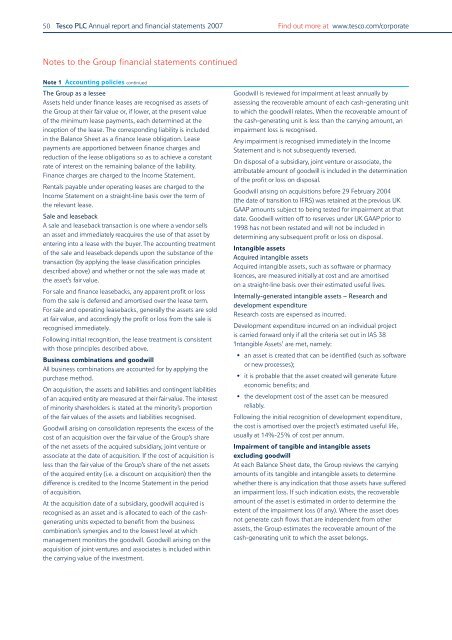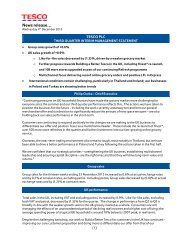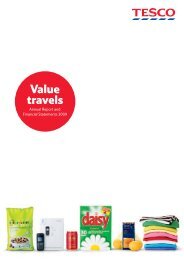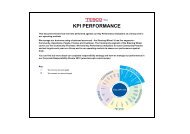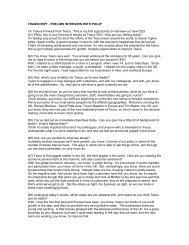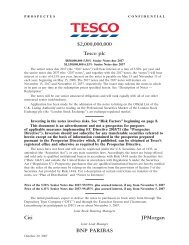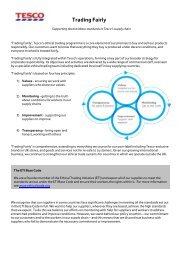Annual Report and Financial Statements 2007 - Tesco PLC
Annual Report and Financial Statements 2007 - Tesco PLC
Annual Report and Financial Statements 2007 - Tesco PLC
You also want an ePaper? Increase the reach of your titles
YUMPU automatically turns print PDFs into web optimized ePapers that Google loves.
50 <strong>Tesco</strong> <strong>PLC</strong> <strong>Annual</strong> report <strong>and</strong> financial statements <strong>2007</strong> Find out more at www.tesco.com/corporate<br />
Notes to the Group financial statements continued<br />
Note 1 Accounting policies continued<br />
The Group as a lessee<br />
Assets held under finance leases are recognised as assets of<br />
the Group at their fair value or, if lower, at the present value<br />
of the minimum lease payments, each determined at the<br />
inception of the lease. The corresponding liability is included<br />
in the Balance Sheet as a finance lease obligation. Lease<br />
payments are apportioned between finance charges <strong>and</strong><br />
reduction of the lease obligations so as to achieve a constant<br />
rate of interest on the remaining balance of the liability.<br />
Finance charges are charged to the Income Statement.<br />
Rentals payable under operating leases are charged to the<br />
Income Statement on a straight-line basis over the term of<br />
the relevant lease.<br />
Sale <strong>and</strong> leaseback<br />
A sale <strong>and</strong> leaseback transaction is one where a vendor sells<br />
an asset <strong>and</strong> immediately reacquires the use of that asset by<br />
entering into a lease with the buyer. The accounting treatment<br />
of the sale <strong>and</strong> leaseback depends upon the substance of the<br />
transaction (by applying the lease classification principles<br />
described above) <strong>and</strong> whether or not the sale was made at<br />
the asset’s fair value.<br />
For sale <strong>and</strong> finance leasebacks, any apparent profit or loss<br />
from the sale is deferred <strong>and</strong> amortised over the lease term.<br />
For sale <strong>and</strong> operating leasebacks, generally the assets are sold<br />
at fair value, <strong>and</strong> accordingly the profit or loss from the sale is<br />
recognised immediately.<br />
Following initial recognition, the lease treatment is consistent<br />
with those principles described above.<br />
Business combinations <strong>and</strong> goodwill<br />
All business combinations are accounted for by applying the<br />
purchase method.<br />
On acquisition, the assets <strong>and</strong> liabilities <strong>and</strong> contingent liabilities<br />
of an acquired entity are measured at their fair value. The interest<br />
of minority shareholders is stated at the minority’s proportion<br />
of the fair values of the assets <strong>and</strong> liabilities recognised.<br />
Goodwill arising on consolidation represents the excess of the<br />
cost of an acquisition over the fair value of the Group’s share<br />
of the net assets of the acquired subsidiary, joint venture or<br />
associate at the date of acquisition. If the cost of acquisition is<br />
less than the fair value of the Group’s share of the net assets<br />
of the acquired entity (i.e. a discount on acquisition) then the<br />
difference is credited to the Income Statement in the period<br />
of acquisition.<br />
At the acquisition date of a subsidiary, goodwill acquired is<br />
recognised as an asset <strong>and</strong> is allocated to each of the cashgenerating<br />
units expected to benefit from the business<br />
combination’s synergies <strong>and</strong> to the lowest level at which<br />
management monitors the goodwill. Goodwill arising on the<br />
acquisition of joint ventures <strong>and</strong> associates is included within<br />
the carrying value of the investment.<br />
Goodwill is reviewed for impairment at least annually by<br />
assessing the recoverable amount of each cash-generating unit<br />
to which the goodwill relates. When the recoverable amount of<br />
the cash-generating unit is less than the carrying amount, an<br />
impairment loss is recognised.<br />
Any impairment is recognised immediately in the Income<br />
Statement <strong>and</strong> is not subsequently reversed.<br />
On disposal of a subsidiary, joint venture or associate, the<br />
attributable amount of goodwill is included in the determination<br />
of the profit or loss on disposal.<br />
Goodwill arising on acquisitions before 29 February 2004<br />
(the date of transition to IFRS) was retained at the previous UK<br />
GAAP amounts subject to being tested for impairment at that<br />
date. Goodwill written off to reserves under UK GAAP prior to<br />
1998 has not been restated <strong>and</strong> will not be included in<br />
determining any subsequent profit or loss on disposal.<br />
Intangible assets<br />
Acquired intangible assets<br />
Acquired intangible assets, such as software or pharmacy<br />
licences, are measured initially at cost <strong>and</strong> are amortised<br />
on a straight-line basis over their estimated useful lives.<br />
Internally-generated intangible assets – Research <strong>and</strong><br />
development expenditure<br />
Research costs are expensed as incurred.<br />
Development expenditure incurred on an individual project<br />
is carried forward only if all the criteria set out in IAS 38<br />
‘Intangible Assets’ are met, namely:<br />
• an asset is created that can be identified (such as software<br />
or new processes);<br />
• it is probable that the asset created will generate future<br />
economic benefits; <strong>and</strong><br />
• the development cost of the asset can be measured<br />
reliably.<br />
Following the initial recognition of development expenditure,<br />
the cost is amortised over the project’s estimated useful life,<br />
usually at 14%-25% of cost per annum.<br />
Impairment of tangible <strong>and</strong> intangible assets<br />
excluding goodwill<br />
At each Balance Sheet date, the Group reviews the carrying<br />
amounts of its tangible <strong>and</strong> intangible assets to determine<br />
whether there is any indication that those assets have suffered<br />
an impairment loss. If such indication exists, the recoverable<br />
amount of the asset is estimated in order to determine the<br />
extent of the impairment loss (if any). Where the asset does<br />
not generate cash flows that are independent from other<br />
assets, the Group estimates the recoverable amount of the<br />
cash-generating unit to which the asset belongs.


